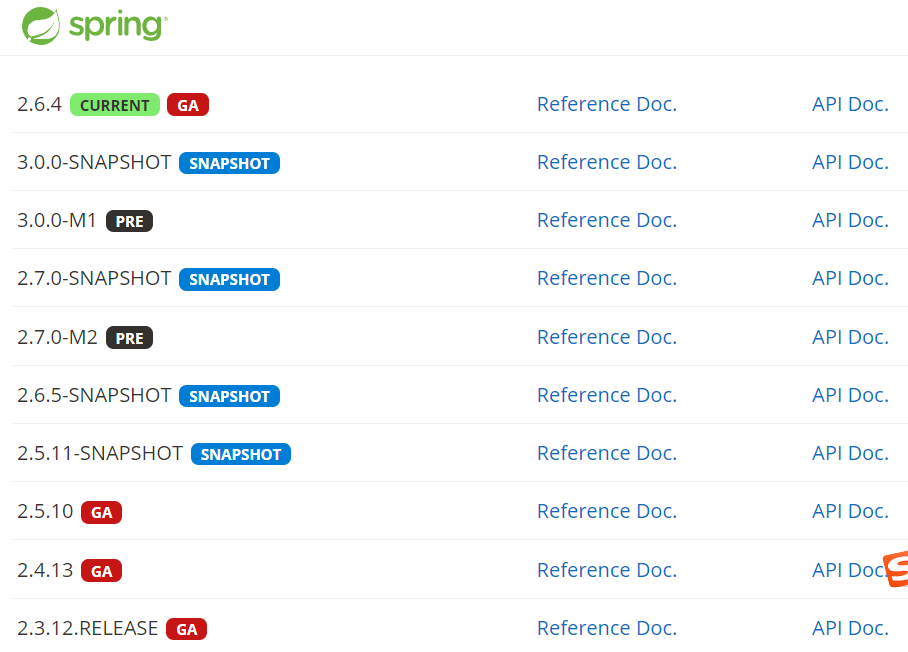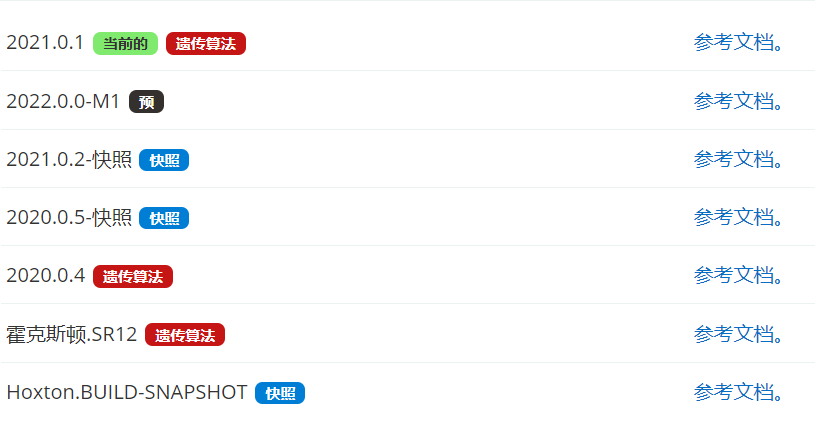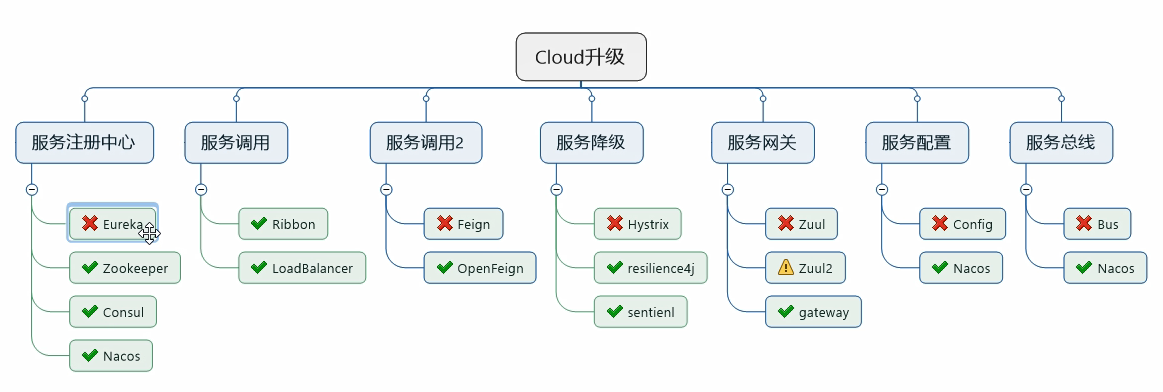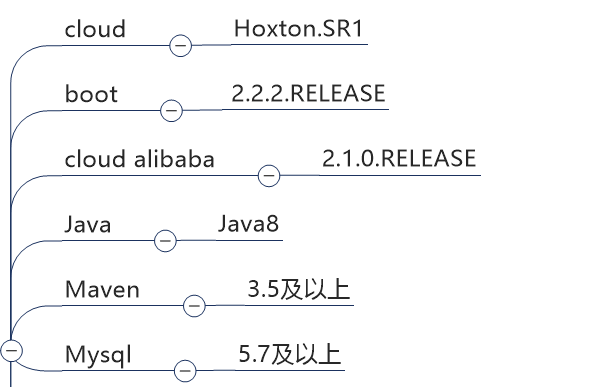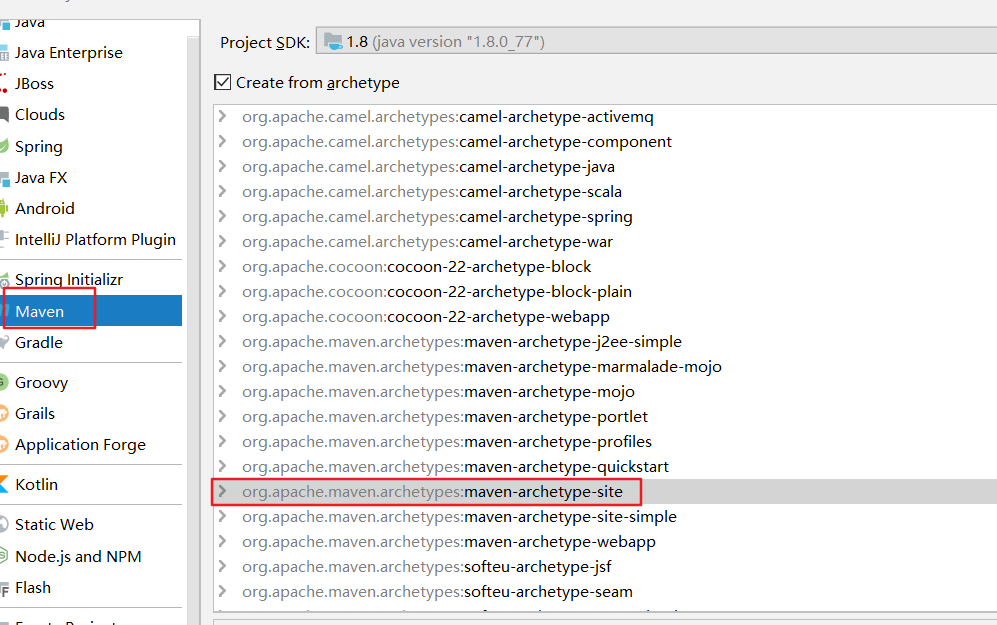一、Springboot和SpringCloud的技术版本选型
1、Springboot官网上的版本
2、SpringCloud官网上的版本
3、Springboot和SpringCloud技术版本的匹配
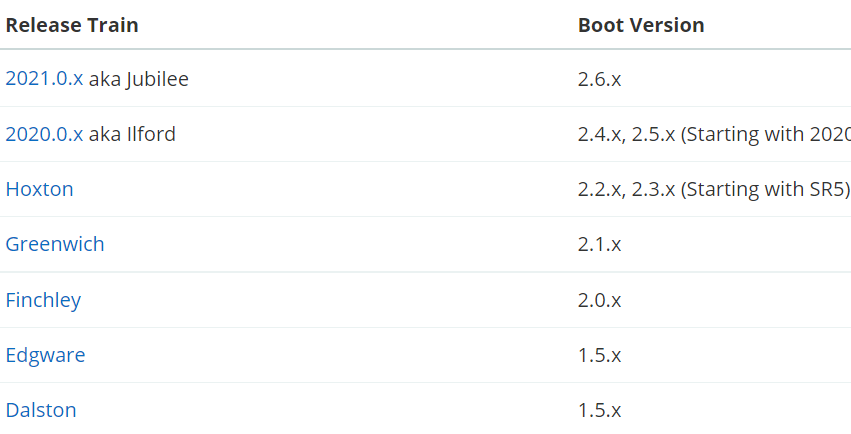
"spring-cloud":{"Hoxton.SR12":"Spring Boot >=2.2.0.RELEASE and <2.4.0.M1","2020.0.5":"Spring Boot >=2.4.0.M1 and <2.6.0-M1","2021.0.0-M1":"Spring Boot >=2.6.0-M1 and <2.6.0-M3","2021.0.0-M3":"Spring Boot >=2.6.0-M3 and <2.6.0-RC1","2021.0.0-RC1":"Spring Boot >=2.6.0-RC1 and <2.6.1","2021.0.1":"Spring Boot >=2.6.1 and <2.6.5-SNAPSHOT","2021.0.2-SNAPSHOT":"Spring Boot >=2.6.5-SNAPSHOT and <3.0.0-M1","2022.0.0-M1":"Spring Boot >=3.0.0-M1 and <3.1.0-M1"},
4、SpringCloud中的组件目前主流所使用的技术选型
二、SpringCloud的项目创建(Springboot 2.2.X 版本 SpringCloud S 版本)
1、使用IDEA构建项目
第一步:
第二步:
第三步:
父工程创建好,则导入pom依赖:
<?xml version="1.0" encoding="UTF-8"?><project xmlns="http://maven.apache.org/POM/4.0.0" xmlns:xsi="http://www.w3.org/2001/XMLSchema-instance"xsi:schemaLocation="http://maven.apache.org/POM/4.0.0 http://maven.apache.org/xsd/maven-4.0.0.xsd"><modelVersion>4.0.0</modelVersion><groupId>com.atguigu.springcloud</groupId><artifactId>cloud2020</artifactId><version>1.0-SNAPSHOT</version><packaging>pom</packaging><!-- 统一管理jar包版本 --><properties><project.build.sourceEncoding>UTF-8</project.build.sourceEncoding><maven.compiler.source>1.8</maven.compiler.source><maven.compiler.target>1.8</maven.compiler.target><junit.version>4.12</junit.version><log4j.version>1.2.17</log4j.version><lombok.version>1.16.18</lombok.version><mysql.version>5.1.47</mysql.version><druid.version>1.1.16</druid.version><mybatis.spring.boot.version>1.3.0</mybatis.spring.boot.version></properties><!-- 子模块继承之后,提供作用:锁定版本+子modlue不用写groupId和versiondependencyManagement--><dependencyManagement><dependencies><!-- 以下三个依赖就是标配--><!--spring boot 2.2.2--><dependency><groupId>org.springframework.boot</groupId><artifactId>spring-boot-dependencies</artifactId><version>2.2.2.RELEASE</version><type>pom</type><scope>import</scope></dependency><!--spring cloud Hoxton.SR1--><dependency><groupId>org.springframework.cloud</groupId><artifactId>spring-cloud-dependencies</artifactId><version>Hoxton.SR1</version><type>pom</type><scope>import</scope></dependency><!--spring cloud alibaba 2.1.0.RELEASE--><dependency><groupId>com.alibaba.cloud</groupId><artifactId>spring-cloud-alibaba-dependencies</artifactId><version>2.1.0.RELEASE</version><type>pom</type><scope>import</scope></dependency><dependency><groupId>mysql</groupId><artifactId>mysql-connector-java</artifactId><version>${mysql.version}</version></dependency><dependency><groupId>com.alibaba</groupId><artifactId>druid</artifactId><version>${druid.version}</version></dependency><dependency><groupId>org.mybatis.spring.boot</groupId><artifactId>mybatis-spring-boot-starter</artifactId><version>${mybatis.spring.boot.version}</version></dependency><dependency><groupId>junit</groupId><artifactId>junit</artifactId><version>${junit.version}</version></dependency><dependency><groupId>log4j</groupId><artifactId>log4j</artifactId><version>${log4j.version}</version></dependency><dependency><groupId>org.projectlombok</groupId><artifactId>lombok</artifactId><version>${lombok.version}</version><optional>true</optional></dependency></dependencies></dependencyManagement><build><plugins><plugin><groupId>org.springframework.boot</groupId><artifactId>spring-boot-maven-plugin</artifactId><version>2.2.2.RELEASE</version><configuration><fork>true</fork><addResources>true</addResources></configuration></plugin></plugins></build></project>
注:
dependencyManagementMaven 使用dependencyManagement 元素来提供了一种管理依赖版本号的方式。通常会在一个组织或者项目的最顶层的父POM 中看到dependencyManagement 元素。使用pom.xml 中的dependencyManagement 元素能让所有在子项目中引用一个依赖而不用显式的列出版本号。Maven 会沿着父子层次向上走,直到找到一个拥有dependencyManagement 元素的项目,然后它就会使用这个dependencyManagement 元素中指定的版本号。这样做的好处就是:如果有多个子项目都引用同一样依赖,则可以避免在每个使用的子项目里都声明一个版本号,这样当想升级或切换到另一个版本时,只需要在顶层父容器里更新,而不需要一个一个子项目的修改 ;另外如果某个子项目需要另外的一个版本,只需要声明version就可。* dependencyManagement里只是声明依赖,并不实现引入,因此子项目需要显示的声明需要用的依赖。* 如果不在子项目中声明依赖,是不会从父项目中继承下来的;只有在子项目中写了该依赖项,并且没有指定具体版本,才会从父项目中继承该项,并且version和scope都读取自父pom;* 如果子项目中指定了版本号,那么会使用子项目中指定的jar版本。
第四步:
如何构建微服务模块?
1、建module2、改pom3、写YML4、主启动5、业务类
4.1 cloud-provider-payment8001 改pom
<dependencies><dependency><groupId>org.springframework.boot</groupId><artifactId>spring-boot-starter-web</artifactId></dependency><dependency><groupId>org.springframework.boot</groupId><artifactId>spring-boot-starter-actuator</artifactId></dependency><dependency><groupId>org.mybatis.spring.boot</groupId><artifactId>mybatis-spring-boot-starter</artifactId></dependency><dependency><groupId>com.alibaba</groupId><artifactId>druid-spring-boot-starter</artifactId><version>1.1.10</version></dependency><!--mysql-connector-java--><dependency><groupId>mysql</groupId><artifactId>mysql-connector-java</artifactId></dependency><!--jdbc--><dependency><groupId>org.springframework.boot</groupId><artifactId>spring-boot-starter-jdbc</artifactId></dependency><dependency><groupId>org.springframework.boot</groupId><artifactId>spring-boot-devtools</artifactId><scope>runtime</scope><optional>true</optional></dependency><dependency><groupId>org.projectlombok</groupId><artifactId>lombok</artifactId><optional>true</optional></dependency><dependency><groupId>org.springframework.boot</groupId><artifactId>spring-boot-starter-test</artifactId><scope>test</scope></dependency></dependencies>
4.2 写YML
server:port: 8001spring:application:name: cloud-payment-servicedatasource:type: com.alibaba.druid.pool.DruidDataSource # 当前数据源操作类型driver-class-name: org.gjt.mm.mysql.Driver # mysql驱动包 com.mysql.jdbc.Driverurl: jdbc:mysql://localhost:3306/db2019?useUnicode=true&characterEncoding=utf-8&useSSL=falseusername: rootpassword: 123456mybatis:mapperLocations: classpath:mapper/*.xmltype-aliases-package: com.atguigu.springcloud.entities # 所有Entity别名类所在包
4.3 主启动类
/*** 主启动类* @author dongxinxin* @create 2022-03-06 13:11*/@SpringBootApplicationpublic class PaymentMain8001 {public static void main(String[] args) {SpringApplication.run(PaymentMain8001.class);}}
